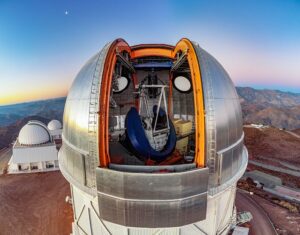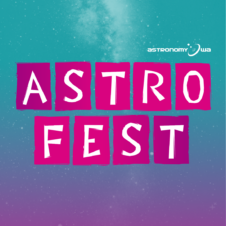New finding offers a clear explanation to quasar ‘urban density’ conundrum.
Astronomers have confirmed their expectation that early-Universe quasars formed in regions of space densely populated with smaller companion galaxies. The Dark Energy Camera (DECam) exceptionally wide field-of-view and special filters were vital in reaching this conclusion, and revealing why previous studies have given conflicting results.
Quasars are the brightest objects in the Universe and are powered by material being pulled inwards towards supermassive black holes at the centres of galaxies. Studies have shown that early-Universe quasars have black holes so massive that they must have been engulfing gas at very high rates, leading most astronomers to believe that these quasars formed in some of the densest environments in the Universe where gas is most available.
However, previous studies looking to prove this have instead produced conflicting results, finding quasars in seemingly empty regions of space. Now, a new study is providing an explanation for these unexpected observations and a framework to connect them with the expected theory.
Trystan Lambert led the study whilst he was a PhD student at Diego Portales University’s Institute of Astrophysical Studies in Chile. Dr Lambert is now a postdoc at The University of Western Australia node at the International Centre for Radio Astronomy Research (ICRAR) where he is continuing his research.

Observations were made using the U.S Department of Energy fabricated DECam mounted on the U.S. National Science Foundation Víctor M. Blanco 4-meter Telescope at Cerro Tololo Inter-American Observatory in Chile. Credit: NOIRLab
Using DECam, the team measured the density of an early-universe quasar environment by counting the companion galaxies nearby a known quasar. To make accurate measurements, the team needed a known quasar with a well-defined distance. Luckily, the distance of quasar VIK 2348–3054 is well known thanks to previous observations by the Atacama Large Millimeter/submillimeter Array (ALMA).
DECam’s massive three-square-degree field of view could then provide an expansive look at its cosmic neighbourhood. It is also equipped with a narrowband filter perfectly suited for detecting its companion galaxies.
“This quasar study really was the perfect storm,” says Lambert. “We had a quasar with a well-known distance, and DECam on the Blanco telescope offered the massive field-of-view and exact filter that we needed.”
DECam’s specialised filter detects a specific light known as Lyman-alpha radiation. When stars are formed, hydrogen is ionised and recombined, emitting an energy signature that can be detected as Lyman-alpha radiation. This allowed the team to count the companion galaxies around the quasar easily.
Lyman-alpha emitters are typically younger, smaller galaxies, and their defined hydrogen peak can be used to measure the galaxy’s distance from other Lyman-alpha emitters. These distance measurements can then be used to construct a 3D map of a quasar’s neighbourhood.
Using this technique, previous studies have found varying densities in the regions around early-Universe quasars. After systematically mapping the region of space around quasar VIK J2348-3054, Lambert and his team found 38 companion galaxies in the wider environment around the quasar, out to a distance of 60 million light-years. This is consistent with their expectation of quasars residing in dense regions. However, they were surprised to find that within 15 million light-years, there were no companion galaxies at all.
“DECam’s extremely wide view is necessary for studying quasar neighbourhoods thoroughly. You really have to open up to a larger area,” says Lambert. “This suggests a reasonable explanation as to why previous observations are in conflict with one another.”
No other survey of this kind has used a search area as large as the one provided by DECam, and just as Lambert’s study found, smaller-area searches of a quasar’s environment can appear deceptively empty. This has given researchers a possible explanation for why past searches have yielded conflicting results.

Artist Illustration of Early-Universe Quasar Cosmic Neighbourhood. Credit: NOIRLab/NSF/AURA/M. Garlick/J. da Silva (Spaceengine)/M. Zamani.
The team does have another possible explanation for the lack of companion galaxies in the immediate vicinity of the quasar, however. Quasars give off such intense radiation, that it may be enough to affect, or potentially even stop the formation of stars in these companion galaxies.
“Some quasars are not quiet neighbours,” says Lambert. “Stars in galaxies form from gas that is cold enough to collapse under its own gravity. Luminous quasars can potentially be so bright as to illuminate this gas in nearby galaxies and heat it up, preventing this collapse.”
As we use the Lyman-alpha radiation from star formation to detect these galaxies, this disruption could make them invisible to our observation methods.
Lambert’s team is currently following up with additional observations to obtain spectra and confirm whether this star formation suppression is a factor. They also plan to observe other quasars to build a more robust sample size.
“These findings show the value of the National Science Foundation’s productive partnership with the Department of Energy,” says Chris Davis, program director for NSF NOIRLab. “We expect that productivity will be amplified enormously with the upcoming NSF-DOE Vera C. Rubin Observatory, a next-generation facility that will reveal even more about the early Universe and these remarkable objects.”

